Unleashing the Power of Generative AI for Data and Analytics
The potential use cases for GenAI are extensive. How are leaders applying this technology in their data and analytics (D&A) function today, and how do they plan to in the future?
One minute insights:
 Most respondents’ D&A functions are engaging with GenAI by adopting or considering use cases
Most respondents’ D&A functions are engaging with GenAI by adopting or considering use cases Top use cases already adopted are data exploration, code generation and
document summarization
Top use cases already adopted are data exploration, code generation and
document summarization Data narrative generation, conversational interfaces for analytics and data exploration could be valuable use cases for respondent D&A functions to adopt over the next 24 months
Data narrative generation, conversational interfaces for analytics and data exploration could be valuable use cases for respondent D&A functions to adopt over the next 24 months Conversational interfaces for analytics, code generation and data exploration are considered the most feasible use cases for adoption in the next 24 months
Conversational interfaces for analytics, code generation and data exploration are considered the most feasible use cases for adoption in the next 24 months More than half of respondents consider skills gaps a main barrier to adoption in their D&A function
More than half of respondents consider skills gaps a main barrier to adoption in their D&A function
Most respondent D&A functions are in the early stages of GenAI adoption
Only 10% of respondents are not planning to explore or implement GenAI for their D&A function. 36% have conducted initial research and plan to implement their findings, and 40% are already using GenAI to some extent.
Which of the following best describes your data and analytics (D&A) function's engagement with generative AI (GenAI)?
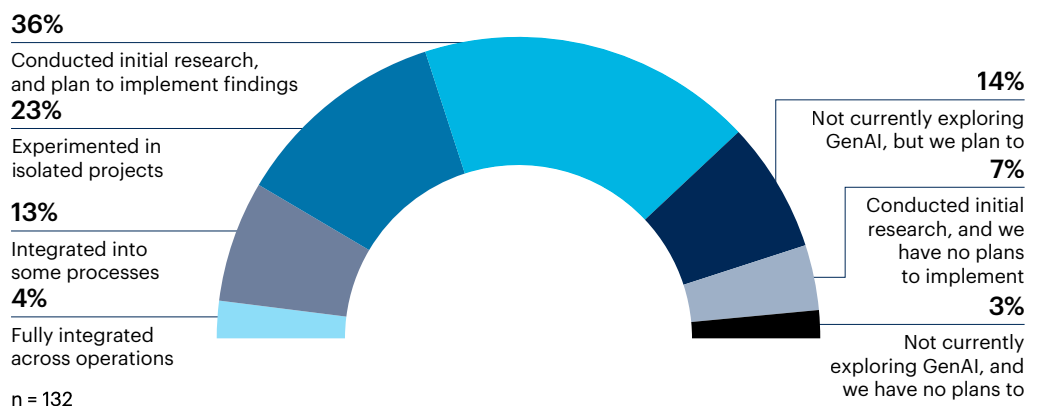
Among the respondents whose D&A functions are currently using GenAI in some capacity (n = 53), the most common applications are for data exploration (49%), code generation (43%) and document summarization (40%).
How is your D&A function currently using GenAI? Select all that apply.
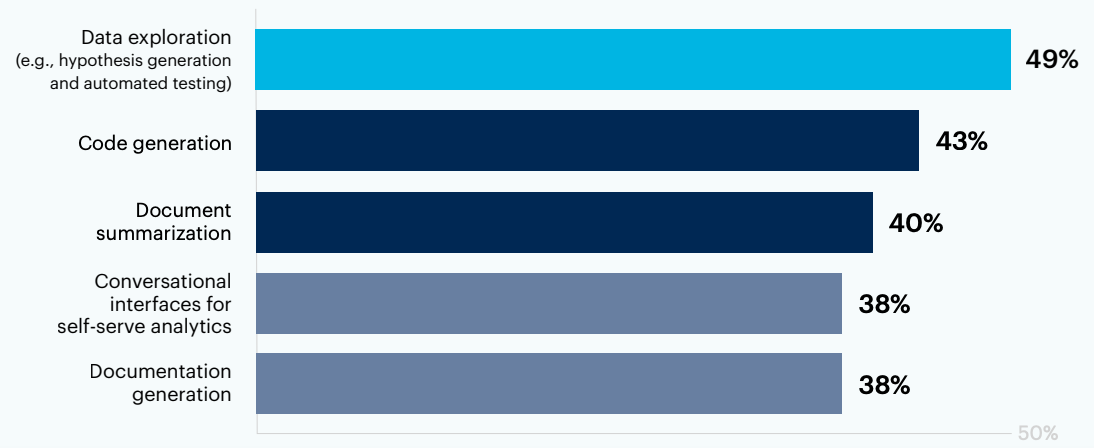
Conversational interfaces for data professionals 36% | Productivity (e.g., generating to-do lists, meeting summaries, etc.) 34% | Data narrative generation (i.e., contextualized explanations of datasets) 32% | Synthetic data generation 19% | Personalized and interactive training for D&A 11% | I don’t know 0% | Other 0%
n = 53
Question shown only to respondents who answered “Experimented in isolated projects,” “Integrated into some processes,” or “Fully integrated across operations” to “Which of the following best describes your data and analytics (D&A) function's engagement with generative AI (GenAI)?”
Question: What is the most significant impact you foresee GenAI having on your D&A function over the next 24 months?
I believe [GenAI] will allow us to make better use of the data that we currently have. We have too much data and that impedes meaningful analytics. It's also a drain on resources as well.
We are hoping it will help us unlock the secrets of our data as we have a lot of hypothesis but lack a clear way to test/prove them.
Data narrative generation among top most valuable use cases to adopt in the next 24 months
Among respondents whose D&A functions are considering or using GenAI (n = 119), the top-selected use cases considered most valuable to adopt in the next 24 months are data narrative generation (41%), conversational interfaces for analytics (39%) and data exploration (39%).
What use cases of GenAI in D&A would be most valuable for your organization to adopt in the next 24 months? Select up to three.
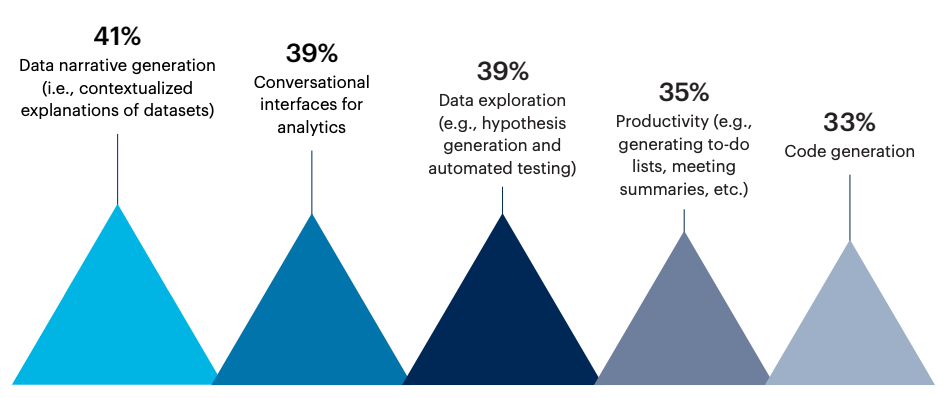
Conversational interfaces for data management 32% | Document summarization 26% | Documentation generation 21% | Synthetic data generation 21% | Personalized and interactive training for D&A 18% | I don’t know 0% | None 0% | Other 0%
n = 119
Question shown only to respondents who answered “Experimented in isolated projects,” “Integrated into some processes,” “Fully integrated across operations,” “Not currently exploring GenAI, but we plan to,” or “Conducted initial research, and plan to implement findings” to “Which of the following best describes your data and analytics (D&A) function's engagement with generative AI (GenAI)?”
As for the GenAI use cases that would be most feasible for their D&A functions to adopt, 50% of respondents said conversational interfaces for analytics would be among their top three. Code generation (44%) and data exploration (44%) were also top use cases for feasibility.
What use cases of GenAI would be the most feasible for your D&A function to adopt in the next 24 months? Select up to three.
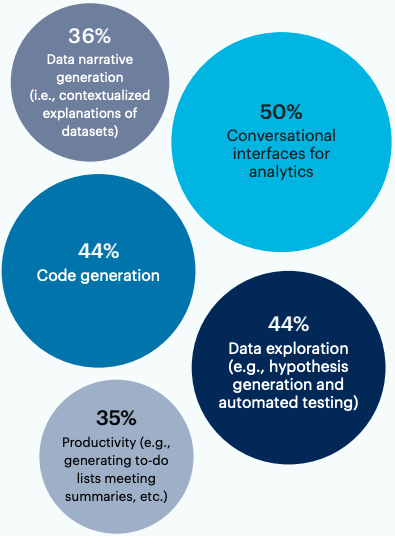
Document summarization 36% | Conversational interfaces for data management 34% | Documentation generation 28% | Synthetic data generation 18% | Personalized and interactive training for D&A 13% | I don’t know 1% | None 0% | Other 0%
Question shown only to respondents who answered “Experimented in isolated projects,” “Integrated into some processes,” “Fully integrated across operations,” “Not currently exploring GenAI, but we plan to,” or “Conducted initial research, and plan to implement findings” to “Which of the following best describes your data and analytics (D&A) function's engagement with generative AI (GenAI)?”
Question: What is the most significant impact you foresee GenAI having on your D&A function over the next 24 months?
[I foresee GenAI] changing the way we explore our outlying datasets. Providing better visibility for data governance and management in a federated model.
GenAI has to be everywhere as soon as possible in any case, so the actual value might be diluted until the hype goes down.
Majority of respondents see skills gaps as a main barrier to adoption of GenAI in D&A
64% of respondents who are considering or using GenAI for D&A (n = 116) see skills gaps as one of the main barriers to adoption. More than one-third of respondents say unclear ROI (37%) or immature D&A ecosystems (35%) are among their main barriers.
What do you see as the main barriers to GenAI adoption for D&A at your organization? Select up to three.
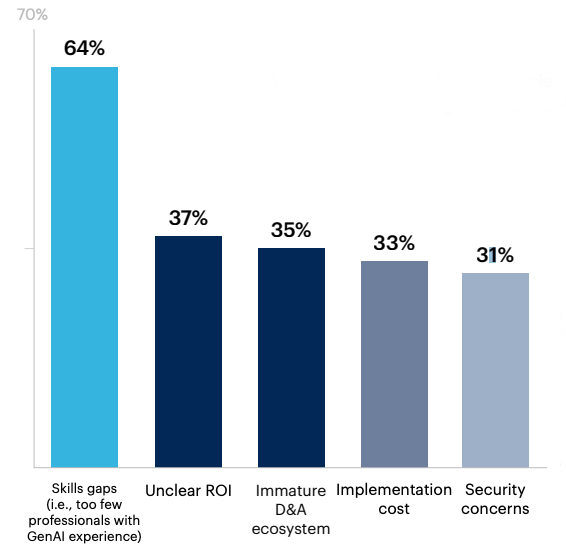
Poor data quality 26% | Complex D&A ecosystem 25% | Regulation and compliance concerns 20% | Ethical concerns 18% | End-user skepticism (i.e., lack of trust) 15% | Governance challenges 12% | Lack of viable use case 8% | Lack of executive interest 8% | Other* 1% | I don’t know 0% | None 0%
n = 119
*Other: Skilled resources for implementation
Question shown only to respondents who answered “Experimented in isolated projects,” “Integrated into some processes,” “Fully integrated across operations,” “Not currently exploring GenAI, but we plan to,” or “Conducted initial research, and plan to implement findings” to “Which of the following best describes your data and analytics (D&A) function's engagement with generative AI (GenAI)?”
Question: What is the most significant impact you foresee GenAI having on your D&A function over the next 24 months?
GenAI is rapidly coming and we have to be prepared. The biggest impact will be the disruption as GenAI displaces other technology and employees need to learn new skills to function in a GenAI environment.
The increased use of AI in D&A has raised some challenges related to bias, accountability and transparency. We are seeing an entire shift in processes that we used to do differently before.

Want more insights like this from leaders like yourself?
Click here to explore the revamped, retooled and reimagined Gartner Peer Community. You'll get access to synthesized insights and engaging discussions from a community of your peers.
Respondent Breakdown

Respondents: 132 IT and data and analytics leaders with knowledge about GenAI applications to D&A who own or collaborate on their organization's D&A strategy